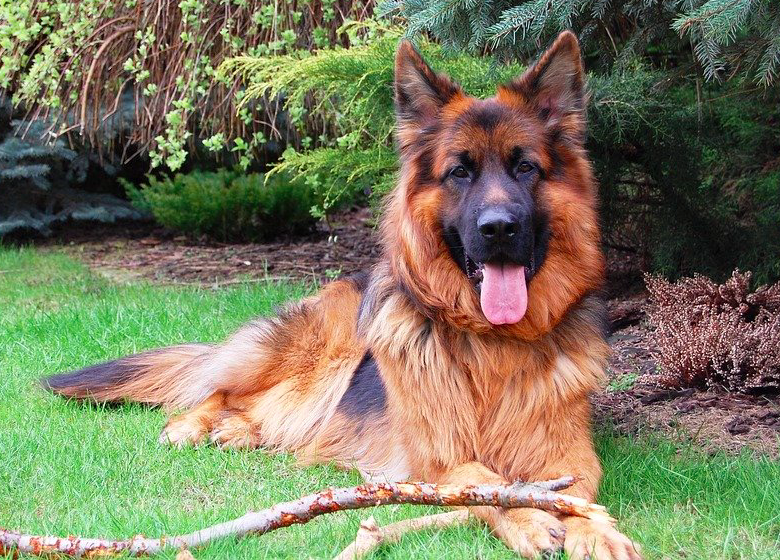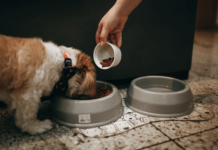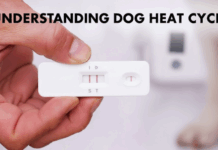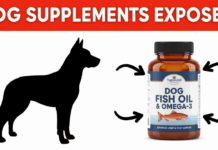Last Updated on May 7, 2021 by Dogs Vets
Which coat is best for German Shepherd
German Shepherds Dogs are undoubtedly the best and most loyal dogs in the world. One of these dogs’ solid and recognizable characteristics is their long, shiny coat, the so-called double-coated German Shepherd dogs.
German Shepherds are famous all over the world for their beautiful thick coats.
These beautiful coats are easily recognizable and have gained increased attention in the dog world. The most well-known and trendy color in German Shepherds is black and tan. Still, there are several different other coat colors you can find in the German Shepherd dog breeds.

German Shepherds Dogs can be thick, sable, saddleback, or two-tone. Coat colors extend from black, white, red, tan, blue, cream, liver, and silver.
You may have heard of some German Shepherd double coats when adopting a dog. Still, you need to know precisely double coats and single coats in the German Shepherd because it’s all associated with maintenance, temperament, shedding, and supplements you need to give for your dog.
So how do you tell the contrast or difference between a single coat and a double coat German Shepherd?
History of the German Shepherd
Where did German shepherds come from?
As the name suggests, the German Shepherd dog breed originated in Germany in the late 1800s. The most intelligent, responsive, and obedient local sheepdogs in Germany were bred to create what is now known as the German Shepherd.
The German Shepherd dog breed was responsible for raising sheep and protecting the herds from predators. They were not considered pets or friends but rather servants for the farmers. Their high level of intelligence, speed, strength and keen sense of smell made them the perfect choice as sheepherders. Although German shepherds were strictly considered workers rather than pets, farmers provided food, protection, and shelter for the breed.
By the beginning of World War I, the German Shepherd was famous throughout Germany and suddenly spread to other parts of the world. People loved German Shepherds because of their loyal and courageous nature.
Because of the breed’s reputation for being brave and easy to train, German Shepherds were embraced as police dogs and sight dogs for the blind. Their excellent sense of smell and courageous nature has made the German Shepherd an ideal police dog. Their faithful observation of what goes on around their environment, along with their patience, has given them the role of leader of the blind on a global scale.
These exceptional qualities and characteristics make the German Shepherd an excellent domestic companion, protector, and friend. At first, the breed is reserved for strangers, but they warm up quickly. This characteristic makes them wonderful guard dogs, especially for children. It is good to socialize them when they are young and take them for long walks or runs throughout their lives.
Single Coat vs. Double Coat – What’s the Difference?
The German Shepherd dogs are primarily seen in 2 variation or types of coats: a single or short coat and a double or long coat. Double coat or long coat breeds will have a second coated coat. This is often referred to as a “guard coat”, which is primarily useful for the dog to protect itself from dirt and water.
The puppy could lose his fur after the 1st month, and the puppy looks like a standard single coat, but the fur will return after the 5th month.
The fur of the second coat in the guard coat is usually foamy and soft and can prevent contact with dirt and water off the dog’s skin, preventing itching. This is helpful because it helps to prevents mud on the dogs skin or unnecessary bacterial infections.
Double coats with a protecting coat can provide double performance in different seasons of the year. In the winter season, dogs will be able to retain the heat generated naturally close to the skin. During the summer, the foamy coat will be able to reflect sunlight, which will help the dog from overheating.
Dogs with a double coat also have an undercoat as well. This undercoat acts as an excellent insulating coat in the winter; the undercoat we call Guard Coat is thicker and more durable. This, along with the second coat, makes the double-coated dog suitable for all types of weather.

Single-coated dogs only have a protective external coat, on the other hand. These dogs are generally not suited to live in cold climates like Antarctica, Canada, Kazakhstan, Mongolia, which are also considered the coldest countries in the world, and in most cases, they are bred in areas that do not need an insulating undercoat.
So it is better to adopt a German Shepherd with a double coat or long coat in colder places.

German Shepherds are mandatorily double -Coated Dogs?
Are German shepherds mandatory double-coated dogs?
German shepherds are generally considered double coated. Nevertheless, they are not all the same. There are different lengths and sizes of their coats. There is no insulating undercoat in all of their coats.
The topcoat (sometimes called the topcoat), called the guard coat, is slightly more “wiry” and abrasive.
The coats underneath are specific to the official race that may compete. In the United States Of America, if a German Shepherd has no undercoat, the dog will be considered a defective dog by the American Kennel Association. They are not permitted to participate in shows. Not all German shepherd dogs are known to have these undercoats, however. There are several types, including:
- Short length coat: 1 inch with an undercoat
- A medium-length coat: which is covered with an undercoat, moreover is commonly known as the guard coat. The coat you always see in the German Shepherd is very common and is necessary for Show lines. This coat is typically usually between one and two inches long.
- Long coat with undercoat: These lengthy coats are at least 2 inches long, usually very thick with an undercoat, and make an overall excellent breed during the winter.
- Long Coat without Undercoat: Long Coat GSD that looks quite similar but will lack the undercoat.

Coat Types and Shedding
One of the most important known factors that may affect the amount of hair your dog has is the type of coat. German shepherd dogs are often referred to as German shedding dogs. These dogs lose a lot throughout the year, regardless of their coat type. However, some types of German Shepherds can have less shedding, so if you are adopting one, you should be well-prepared.
Moreover, you should make sure to brush your double German Shepherd dog coat regularly. Brushing once every other day is ideal, but if that’s not possible, be sure to brush at least a minimum of 3-times in a single week.
What Are the Most Common German Shepherd Dogs Color Patterns?
- A Black Color and Tan
- Black and Red
- Blue
- Bicolor or Two-Tone (black with cream-colored heels)
- Liver and Tan
- Sable or Gray
- White
- Black
Black and Tan German Shepherd

The black and tan is the most popular and widespread color combination you can find in a German Shepherd. The Famous German shepherds (e.g., Rin Tin Tin,) and show German shepherds have this coloring.
These dogs usually have tan or cream paws, belly, and neck, with black “saddles” on their backs that extend from the neck down to the tail. They may also have distinctive black “masks” on their faces.
Both American and Canadian lines prefer this coloring. Some dogs will have some “silver” (a very light cream color) on their stomachs, which some breeders find acceptable.
Black and Red German Shepherd

Dogs in the German show line often have this coloring. They have the same pattern as black and tan dogs, but the tan part is more red or sometimes even strawberry blonde.
In some cases, instead of black and red, they will be black and silver. The silver part is described as a light shade of cream. Black and silver German Shepherds are not at all uncommon, but they are not as commonly shown as black and red ones.
Blue or Liver/Tan

These dogs are only rarely seen at shows because these multiple colors are an indication of diluted genes. They may still be considered as a purebred German Shepherds, but their lack of typical black coloration indicates that there was breeding among canines that did not have the appropriate colors somewhere in their lineage.
Blue german shepherd dogs are described as a slight dilution of black. Depending on the persistent dark blue color is, these dogs could still be shown in the ring. However, breeders consider light blue to be undesirable.
German Shepherds who are considered liver and tan have the appropriate saddle and body mask markings. Still, instead of the normal black, they have a rich brown color.
Bicolor or Two-Tone German Shepherds

Despite being called “two-tone,” these dogs are one solid color: black. The dog’s entire body is mostly black except for a few brown or tan areas, usually on the feet, under his tail, in the eyebrows and sometimes there is a small spot on the dogs cheeks.
The head, legs, back, and tail should be completely black. Sometimes they have brown feet, but their heels must also be black to be considered a bicolour or two-tone German Shepherd in the ring.
Dogs that have black heels are sometimes appropriately called “Tarheels.” They can also have some dark brown on their faces and around their ears, but the brown or tan markings are usually not very prominent.
Sable or Gray

Sable German Shepherds are more commonly found in working lines than in show lines because working dogs do not have an excellent coloration pattern for the show. They normally have banded fur, which means that each hair is multi-colored. Standard colors include silver, brown, black, and sometimes red. A layer of black hair usually masks this set of hairs.
Their coats change a lot in the first two years of their lives, so it can be difficult to predict what a little sable puppy will look like as an adult german shepherd. Sable patterns come in varieties, with black on cream being the most common. Liver on cream, black on red, and silver on cream are also very possible.
The Gray German Shepherd Dogs are a type of sable, but their fur is more wolf-like in color. This color is often referred to as wolf gray. These dogs may have black on silver or gray on silver coats.
White German shepherd Dogs

A German shepherd can also be entirely white or entirely black. The white variety is simply a display of recessive genes, similar to blond hair in humans, and is not indicative of albinism. Sadly, white German Shepherd dogs are not allowed to compete or participate in most kennel shows, but they can compete in obedience and agility competitions.
Black German shepherd Dogs

The Black German Shepherd Dogs are also the result of some of the recessive genes. They will sometimes have white patterns on their chests. Unlike focal black dogs that start out predominantly black but take on a more typical appearance with age, they remain black for the rest of their lives.
FAQ’S
Is a German Shepherd a good family dog?
German Shepherds dog can be very gentle companions and protectors of the family with proper training and socialization. It is an ideal breed for active families. This breed’s intelligence and protective behavior can make it a good choice for families with children as long as the GSD is trained correctly.
Are German Shepherds aggressive?
The German Shepherd dog breed is known for its aggressive behaviors and tendencies. … German Shepherds are considered good guard dogs, but if they are not trained guard dogs, any aggressive tendencies should be curbed.
Is the German Shepherd dangerous?
The GDS breed is naturally very protective of its owners. If the German Shepherd dog is not properly socialized, it can become overly aggressive among strangers. German Shepherds have been involved in various fatal dog attacks, and many attack episodes have resulted in catastrophic injuries.
How Often Should You bathe your Dogs?
Bathing your German Shepherd can or may remove 20% more hair. If you only brush when your dog is slightly damp, it will help remove more hair. Don’t usually bathe your dog too often, as this will remove the natural oils, making your coat duller and less shiny. It is best not to bathe your German Shepherd every 4-5 months.
German Shepherds that do not have an undercoat require less care during the spring and fall months, but this does not make any big difference in appearance.
Can You Shave a German Shepherd?
The German Shepherd dog’s undercoat is an excellent insulator, and you’ll probably feel it keeps them warm during the colder months. But the fur layers keep them cool in the summer and insulate them from the hot air.
It is, therefore, a bad practice to shave a German Shepherd in a double layer.
If you have one of these puppies or plan to adopt one, it makes sense that you want to do everything possible or in your power to keep his coat healthy and shiny. Proper nutrition and grooming habits are great ways to make sure your dog is happy and looks good!
What is the price of a German shepherd double coat?
So the price of a German Shepherd in India also depends on its coat type. Let’s say if you want to buy the short coat the price starts from 8000 and for the double coat it starts from 10000, and the long coat starts from 18000.
What is the best coat for the German Shepherd?
A medium-length double coat is considered the most desirable. This type of coat can be quite shaggy, depending on the dog. A shorter coat is sometimes considered acceptable by the breed standard.
How can you tell if your German Shepherd is purebred?
Without documentation, the only sure way to know if your pet is indeed a purebred German Shepherd is through DNA testing. As Vetstreet explains, the entire process is very simple. Order a DNA kit from a reputable firm and use the swab provided to get a sample of your dog’s cheek cells.
Is the German Shepherd’s hair soft?
Their undercoat is the coat that is closest to their skin.
These are very soft and should be cleaned with a brush. The undercoat is important to your dog because it can help them stay warm when it’s cold. This is why German Shepherds are so good at functioning in all kinds of different weather conditions.
How do I know if my German Shepherd has an undercoat?
You’ll notice that your German Shepherd dog is blowing his coat more frequently, when you start to see clumps of light-colored undercoat hair coming out when you brush him. This is a good time to give your dog a brush once over and a warm bath.
How do you know if a German Shepherd puppy is a longhair?
Identifying a Long Coated GSD
You’ve probably seen a short-haired shepherd, so it will be easy to compare the two. They have tufts of fur around the ears, behind the legs, hindquarters, around the tail, and between the legs. Most long-haired shepherds do not have an undercoat and, as a result, have a shiny appearance.
What does double coat mean?
A coating type consisting of two layers, double-coated dogs have a dense undercoat of short hairs (with a woolly texture) under a top coat of longer hairs called guard hairs. This dense undercoat protects a dog from both hot and cold temperatures, and the topcoat helps repel moisture and dirt.
How rare are black German shepherds?
Black German Shepherd puppies
In fact, only 6.8% of all German Shepherd puppies born in the world continue to be black. And that explains the intentional breeding of black German shepherds.
What is the rarest-color of a German Shepherd Dog?
Blue German Shepherd
The blue German Shepherd dog is one of the rarest variants of the breed and can cost up to 5-times more than the traditional black variants. This color is declared a serious defect, and therefore these dogs are not allowed to compete in shows, although they are recognized by the American Kennel Club.
How often should German shepherds be washed?
Every 3-4 months
Unlike other breeds, German shepherds do not need to be bathed often. In fact, they are best washed only every 3-4 months. German Shepherds have a double coat: the overcoat and the undercoat.
Do German shepherds need their undercoat removed?
Double-coated dogs like the German Shepherd will need an undercoat rake to remove superfluous, loose hair from the undercoat, especially during shedding season. If you’re looking for easier hair removal, high-speed dryers like those from K9 Dryers have become an essential grooming tool.
Are German shepherds good with children?
Yes, a German Shepherd is child-friendly and loves children when properly socialized and trained. They are a very intelligent breed that has been specially selected throughout history for their loyal and watchful temperament with their families.
See also: The Rottweiler Dog History, Breed, Diet, Cost, Size, Training
Fact Check
We strive to provide the latest valuable information for pet lovers with accuracy and fairness. If you would like to add to this post or advertise with us, don’t hesitate to reach us. If you see something that doesn’t look right, contact us!
Reference: Pethelpful.com, Wikipedia and Germanshepherddog.info

















